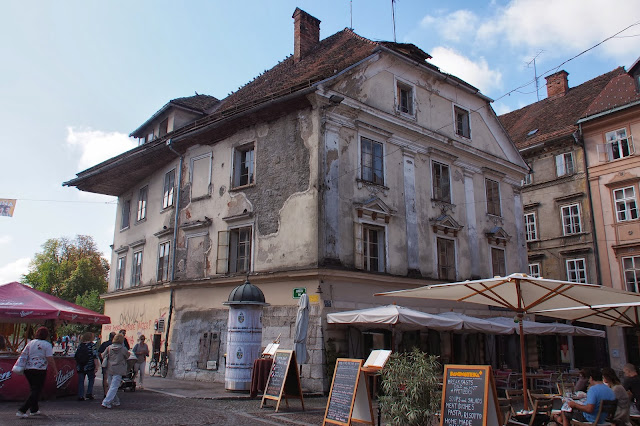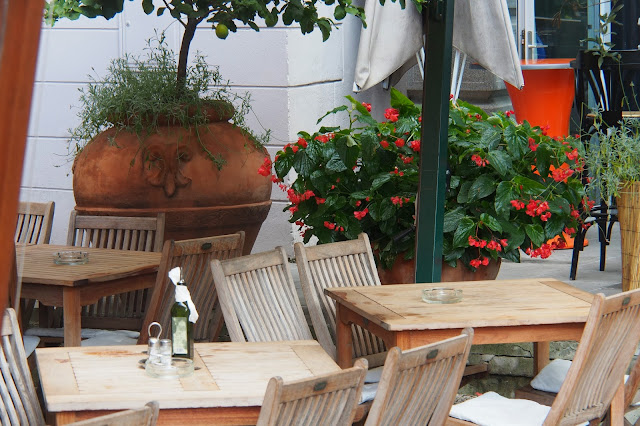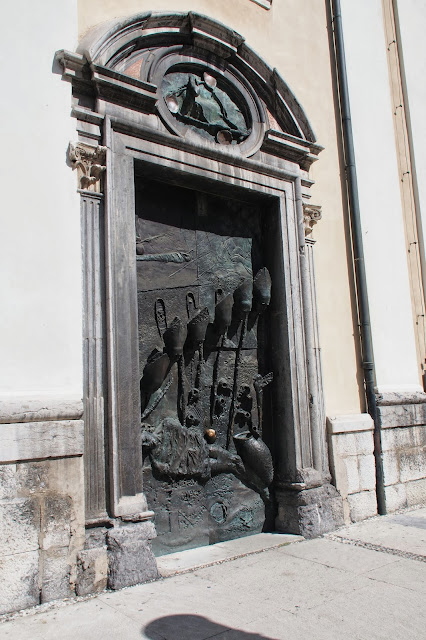When we left Lake Bled, we were taken to Ljubljana or Laibach (German) or Lubiana (Italian), the capital and largest city in Slovenia at the heart of the the Ljubljana Basin some 1000 feet above sea level, with slightly under 300,000 people, a city heavily influenced by German, Slavic and Roman cultures and now the cultural, educational, economic, political and administrative hub of Slovenia, independent since 1991 after the break-up of the former Yugoslavia. Ljubljana is some 87 miles west of Zagreb, 320 miles northwest of
Belgrade, 160 miles east of Venice, 220
miles southwest of Vienna, 250 miles southwest of
Budapest and enjoys humid subtropical oceanic
climate, tinged with continental characteristics such as warm summers and moderately cold
winters. It's warmest in July and August (with temperatures of 25-30 °C), coldest in January(with temperatures oscillating around 0 °C )and is frost free for about 3 months a year with about 10 days of temperatures above 30 °C. Its 55 inches rainfall each year is evenly distributed through the four seasons with winter and spring slightly drier and with thunderstorms from May to September. It has about 7 weeks of snow from December to February and is affected by fog 2 months per year, mostly in autumn and winter with sunny and warm summers.
It's German name Laibach, used until 1918, is actually a hybrid of German and Slovene and is derived from the river flowing through it viz. the Ljubovid (meaning "one of a kind appearance".) Its city symbol is the Ljubljana Dragon, depicted on the coat of arms of the Ljubljana Castle tower and also on the Dragon Bridge (Zmajski most), symbolizing power, courage, and greatness.There are different accounts of its origins. According to Greek legend, the Argonauts on their return home after having taken the Golden Fleece found a large lake surrounded by a marsh between the present-day towns of Vrhnika and Ljubljana. It is there that Jason struck down a monster. This monster has become the dragon that today appears on the city coat of arms and flag but it's historically more believable that the dragon was adopted from Saint George, the patron of the Ljubljana Castle chapel built in the 15th century. In that legend, the dragon represents the old ancestral paganism overcome by Christianity. Some say that the dragon was at first only a decoration above the city coat of arms and only later became an inseparable part of it.
It was some 4000 years ago that the Ljubljana Marshes (south of the town) and the largest marshes in Slovenia, was first settled in small pile dwellings, relying on hunting, fishing and primitive agriculture and getting around the marches in dug out tree trunks used as canoes. Their archaelogical remains are now preserved in the town of Ig and designated a UNESCO World Heritage. Then came the Celts, the Taurisci, the Ostogoths and the Lombards. Around 50 BC, the Romans built a military encampment which later became a permanent settlement of some 5,000 to 6,000 called Iulia Aemona but the Roman fort was later destroyed by the Huns under Attila's orders. Then around the 6th century, the ancestors of the Slovenes moved in and in the 9th century, it came under Frankish domination. Not much is known about the area during the settlement of Slavs in the period between the downfall of Emona and the Early Middle Ages but it's known that around 1220, it got the right to establish itself as a town under the Holy Roman Empire and its artisans began organizing themselves into guilds but it got the right to hold a market fair a little earlier, around1200, at the Old Square (Stari trg),at that time one of the three districts there (including the area called "Town" ("Mesto") built around the predecessor of present-day Ljubljana Cathedral on one side of the Ljubljanica river, and New Square (Novi trg) at the other side.The Franciscan Bridge (when the Teutonic Knights, the Conventual Franciscans, and the Franciscans settled in the town), a predecessor of present-day Triple Bridge and the Butchers' Bridge then connected the walled areas with wood-made buildings. In 1327, the Ljubljana's "Jewish Quarter" came into being, with its own synagogue, but nothing is left now except the one street called the "Jewish street" because they were expelled by Emperor Maximilian I in 1515 because they failed to pay a certain sum to stay there. From 1270, the town was ruled by King Ottokar II of Bohemia, but was conquered in 1278 by Rudolph of Habsburg and from 1279 until 1335, it was administered by the Counts of Gorizia and became the capital city of Roman province of Carniola and renamed Laibach and it was owned by the House of Habsburg until 1797.
Foreign architects built and renovated numerous monasteries, churches, and palaces in Ljubljan numerous monasteries, churches, and palaces in Ljubljan and introduced some Baroque architecture in the middle and the second half of the 17th century. In 1702, the Ursulines settled there and the following year, they opened the first public school for girls in the Slovene Lands. Some years later, they started building the Ursuline Church of the Holy Trinity. The Napoleonic interlude saw Ljubljana as "Laybach" as the capital of the Illyrian Provinces from 1809 to 1813. In 1815, the city became Austrian again and until 1949, was made the administrative center of the Kingdom of Illyria in the Austrian Empire. In 1821 it hosted the Congress of Laibach, which fixed European political borders for years to come.The first train arrived in 1849 from Vienna and in 1857 the line was extended to Trieste. In 1895, Ljubljana, then a city of 31,000, suffered a serious earthquake measuring 6.1 degrees on the Richter scale and destroying a tenth of its 1,400 buildings. This led to the reconstruction of a number of districts, rebuilt between 1896 and 1910 in the Vienna Secession style, referred to as the "revival of Ljubljana" and such architectural changes can still be seen today. That was also when its urban administration, health, education and tourism were reformed led by its energetic mayor Ivan Hribar.
In 1918, following the end of World War I and the dissolution of Austria-Hungarian Empire, the region joined the Kingdom of Serbs, Croats and Slovenes ie. Yugoslavia. In 1929, Ljubljana became the capital of the Drava Banovina, a Yugoslav province and became the capital of Slovenia in 1991 when Slovenia achieved independence from The Soviet Union.
This is the Congress Square(Kongresni trg), the centre of all important public buildings, , built in 1821 for
ceremonial purposes such as Congress of Ljubljana after which it was
named. Since then it has been used as an important center for political
ceremonies, demonstrations and protests, such as the ceremony at
creation of Kingdom of Yugoslavia, ceremony of liberation of Belgrade,
protests against Yugoslav authority in 1988 etc. It also accomodates the University of Ljubljana, the Slovenian
Philharmonic, the Ursuline Church of the Holy Trinity, and Slovenska matica.
To the right of the photo is the Star Park (Park Zvezda). In 2010
and 2011, the square was heavily renovated and is now mostly closed to
road traffic on ground area and there five floors for
commercial purposes and an underground parking lot there.
An old fountain at the Star Park

This is the House of Congress
This is the Hall of the Slovenia Philhamonia Society, first established in 1701.The first building to the right at the far end is the municipal office.
This is the University of Ljubljana, established in 1919
A bust of Josef Hudetz the architect of the University who founded the university with Ivan Hribar and Danilo Majaron1859-1931
A fountain in front of the university.
Above the concert hall is the Ljubljana Castle
(Ljubljanski grad), a medieval castle with Romanesque, Gothic, and
Renaissance architecture at the summit of the Castle
Hill that dominates the city center, built in the 12th Century as a residence of the Margraves, later
the Dukes of Carniola. In 1848, the Outlook Tower of the Castle was added and houses a guard whose duty it was to fire cannons warning
the city in case of fire or announcing important visitors or events, a
function the castle still holds today. Today cultural events and weddings
also take place there.Since 2006, a funicular has linked the city
center to the castle atop the hill.
This is the statue of the
Slovene national poet France Prešeren with a muse behind him at the heart of another important square of the town, Prešeren Square (Prešernov trg),named after him. His statue was created by Ivan Zajec in 1905 but the pedestal was designed by Max Fabiani. The square and
surroundings have been closed to traffic since 1 September 2007.Only a
tourist train leaves Prešeren Square every day, transporting
tourists to the Ljubljana Castle. Behind it is the Franciscan Church of the Annunciation (Frančiškanska cerkev), the parish church of Ljubljana - Annunciation Parish. Built between 1646 and 1660 (the bell towers following later), it replaced an older Gothic church on the same site. its layout takes the form of an early-Baroque basilica with one nave and two rows of lateral chapels. The Baroque main altar was executed by the sculptor Francesco Robba. Much of the original frescos were ruined by the cracks in the ceiling caused by the Ljubljana earthquake in 1895 and new frescos were painted by the Slovene impressionist painter Matej Sternen.
Another view of the Cathedral
A full view of the Cathedral
To the right of the Cathedral is the Urbank, one of the largest banks in Slovenia
Another view of the Prešeren Square
Trees everywhere, even in front of the bank
At one side of the square is the Triple Bridge (The Trnovo Bridge), the most
prominent part of Plečnik's renovation of the banks of the Gradaščica, right in front of Trnovo Church to its south which joins the neighborhoods of Krakovo and Trnovo, the oldest
Ljubljana suburbs, known for their market gardens and cultural
events.Built between 1929 and 1932, it's distinguished by
its width and two rows of birches that it bears, because it was meant to
serve as a public space in front of the church. Each corner of the
bridge is capped with a small pyramid, a signature motif of Plečnik's,
whereas the mid-span features a pair of Art-Deco male sculptures. There
is also a statue of Saint John the Baptist on the bridge, the patron of
the Trnovo Church. It was designed by Nikolaj Pirnat. There was originally only one bridge, which linked
Central Europe and the Balkans. To prevent a 1842 stone arch
bridge from being a bottleneck, two additional pedestrian bridges on
either side of the central one were added in 1932 according to the
Plečnik's 1929 design. He decorated them with large stone balusters and
lamps. There are two staircases, leading to terraces above the river,
the banks with poplars, and to the Ljubljana fish market below. Two Plečnik's
urban axes of Ljubljana, the water axis and the Ljubljana Castle–Rožnik
Axis, cross at the bridge.
The Ljubjana River
Trees in front of and in between bridges, even in the middle of the square itself
Another view of the Triple Bridge
A street musician at the bridge
The river is lined with trees and is lined with terrace bars on both sides where one can take a leisurely drink or have a cafe and some snacks. I wanted to sit down to do so but there was so much to see and so little time. What a pity !
This is the old town built around the river
This is part of the old town
Close by the Dragon Bridge at the other end of the old town, one finds this street with overhanging shoes. The Dragon bridge used to be called "the Cobbler's Bridge".
Shoes all over the street!
Some of the shoes. What a sales promotion idea!
A really old building in poor condition a short distance from the Triple Bridge
Another Street artist on the street.
It had been raining the previous night but we were lucky. By the time we arrived at the old town, it had stopped.
It was a very pleasant town: there were trees and flowers everywhere.
A statue of Mahler at the side of the Revolution Square, now called the Republic Square.
There were cafes on both sides of the street leading to the Republic/Revolution Square, where demonstrations would be held on important controversial issues. It was also here that Slovenia proclaimed its independence in 1991.
Some students having a drink at a terrace cafe at the the Revolution Square
Some workers were busy doing street repairs
The old fashioned window of a bookshop nearby at the riverbank sidewalk
The people love flowers and would place pots of flowers at every window sill
A window display in one of the shops along the river bank from a wedding planner.
Some people relaxing at one of the river side cafes
Wine for consumption at one such roadside bar
Another one of such roadside cafe-bar-restaurants
Again flowers everywhere
A very musical bar.
How relaxing it would be to be sipping some coffee, lemonade or a glass
of wine under the tree on one of those comfortable rattan chairs or
sofa? But I had to move on.
To another square, Cyril-Methodius Square (Ciril-Metodov trg)., which had been there since 18th century. But it got its present looks only at the end of the 19th century after the 1895
Ljubljana earthquake, when Max Fabiani designed the square as the hub of four
streets and four banks, and in the 1980s, Edvard Ravnikar proposed the
circular design and the granite block pavement.
This is part of the Square. In the middle is a tall monument, dedicated to culture
Behind the monument, one can see the Ljbljana Stolnica (or the Ljbljana Cathedral or St Nicholas Cathedral) for the archdioscese of Ljubjana, first set up in 1461, marked by its twin towers and green dome. Nearby is the Central Market and the Ljbljana Central Market and the Town Hall. It's baroque design was done by the Jesuit architect Andrea Pozzowith two side chapels shaped in the form of a Latin cross built between 1701-1706 whilst its green dome was built in 1841. Its interior is decorated with Baroque frescos painted by Guilio Quaglio between 1703-06 and 1721 and 1723.
The very unusual bronze door of the Cathedral
One can see various bishops caring for Jesus on its bronze door.
One of the side chapels at the Cathedral
Jesus at one of the side alters.
The Holy Mother of God
Another side altar.
A religious painting of the angel announcing that the Blessed Virgin is pregnant with God.
There is natural light above every side altar
The interior is dark except where there is a picture of God: here one depicting the visit of of the infant Jesus by the 3 Magis from the East.
There are many paintings, all of the holy child
One can see the frescos on the roof of the Cathedral and the top of the dome
Faithfuls lighting up candles at the Cathedral
Another corner of the square
Again another street full of restaurants, right in the middle of the street. The Prserens Square is in fact surrounded by circular streets.
This is the location of the town fair. There's a market fair there every weekend.
These are some of the stalls
All kinds of vegetables on sale
carrots, cucumbers, spring onions, beet roots etc and salad dressing
oranges, pears, berries, grapes etc
tomatoes, green and red pepper, apples etc.
Beautiful Pumpkins
All kinds of cheese
Biscuits and cakes
Honey
Prices in colorful notices
A bottle of oil in the shape of the body of a naked woman, presumably meant for male chefs
All kinds of souvenirs
These two girls seem to be having fun looking around and playing.










































































沒有留言:
張貼留言